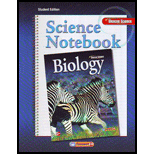
Concept explainers
To identify:
Ways scientists interpret relationships among species by completing the given organizer.
Introduction: Darwin gave a new theory of natural selection that could explain evolution of species. The theory of evolution states that all organisms on earth have a common ancestor. There are many evidences that suggest this; such as structural adaptations, fossil records, comparative anatomy, embryology, biochemistry, geographical distribution etc.
Answer to Problem 5MI
Explanation of Solution
Fossils- Fossils provide most significant evidence of evolutionary change. They provide record of species that lived long ago and help in comparing species of today with ancient species. They help in determining ancestry of organisms and patterns of evolution.
For example some dinosaur fossils show feathers of modern birds and teeth and bony tails of reptiles. This not only suggested that dinosaurs could be classified as birds but also suggested that birds retained some features of dinosaurs.
Darwin predicted existence of many fossil intermediates between species. Today, scientists studying evolutionary relationships have found many transitional fossils that contain features shared by many species.
Anatomy- Comparative anatomical studies suggest some species have common ancestor. Evolution predicts that an organism’s body parts are more likely to be modifications of ancestral body parts than they are to be entirely new features. Anatomically similar structures inherited from a common ancestor are called homologous structures. Bird wings and reptile legs are homologous structures. In some cases such as in kiwis, a functioning structure like wing is smaller or less functional. It cannot be used for flying. Such structures are called vestigial structures. Features of ancestors that no longer have a function for that species will become smaller over time until they are lost. All anatomically similar features are not evidence for common ancestry. Some structures have similar functions but differ in construction. They are not inherited from a common ancestor. These are called analogous structures. Wing of an eagle and wing of a beetle help the species to fly but they have different origins. This suggests that functionally similar structures can evolve independently in similar environments.
Embryology- Comparative embryology also provides some evidences of evolutionary relationships. Vertebrate embryos show homologous structures during certain phases of development but become different structures in adult forms. Embryo is an early stage of development of plant or animal. The shared features in the embryos suggest that vertebrates evolved from a shared ancestor.
Biochemistry- Comparative biochemistry provides evidence for common ancestry. Data shows that there are many complex molecules that organisms share. Cytochrome c is a highly conserved enzyme that is needed for respiration in animals. It is found that the amino acid sequences in cytochrome c in humans and other animals have undergone slight variations but the molecule has changed very little over time.
Evolutionary theory predicts that molecules in species with a common ancestor should share certain amino acid sequences. The more closely related the species are, the greater will be the number of sequences they share. Cytochrome c of pig and monkey share more amino acid sequences with humans than cytochrome c in bird shares with humans.
Biogeography- The study of distribution of plants and animals on Earth is called biogeography. Migration patterns explained why islands have more plant diversity than animal diversity. Evolution is closely related to climate and geological forces, especially plate tectonics. This also explains ancestral relationships seen in fossils and living organisms today.
Chapter 15 Solutions
Biology Science Notebook
Additional Science Textbook Solutions
Microbiology: An Introduction
Microbiology with Diseases by Body System (4th Edition)
Microbiology with Diseases by Body System (5th Edition)
Biological Science
Microbiology: An Introduction
Anatomy & Physiology (6th Edition)
 Human Anatomy & Physiology (11th Edition)BiologyISBN:9780134580999Author:Elaine N. Marieb, Katja N. HoehnPublisher:PEARSON
Human Anatomy & Physiology (11th Edition)BiologyISBN:9780134580999Author:Elaine N. Marieb, Katja N. HoehnPublisher:PEARSON Biology 2eBiologyISBN:9781947172517Author:Matthew Douglas, Jung Choi, Mary Ann ClarkPublisher:OpenStax
Biology 2eBiologyISBN:9781947172517Author:Matthew Douglas, Jung Choi, Mary Ann ClarkPublisher:OpenStax Anatomy & PhysiologyBiologyISBN:9781259398629Author:McKinley, Michael P., O'loughlin, Valerie Dean, Bidle, Theresa StouterPublisher:Mcgraw Hill Education,
Anatomy & PhysiologyBiologyISBN:9781259398629Author:McKinley, Michael P., O'loughlin, Valerie Dean, Bidle, Theresa StouterPublisher:Mcgraw Hill Education, Molecular Biology of the Cell (Sixth Edition)BiologyISBN:9780815344322Author:Bruce Alberts, Alexander D. Johnson, Julian Lewis, David Morgan, Martin Raff, Keith Roberts, Peter WalterPublisher:W. W. Norton & Company
Molecular Biology of the Cell (Sixth Edition)BiologyISBN:9780815344322Author:Bruce Alberts, Alexander D. Johnson, Julian Lewis, David Morgan, Martin Raff, Keith Roberts, Peter WalterPublisher:W. W. Norton & Company Laboratory Manual For Human Anatomy & PhysiologyBiologyISBN:9781260159363Author:Martin, Terry R., Prentice-craver, CynthiaPublisher:McGraw-Hill Publishing Co.
Laboratory Manual For Human Anatomy & PhysiologyBiologyISBN:9781260159363Author:Martin, Terry R., Prentice-craver, CynthiaPublisher:McGraw-Hill Publishing Co. Inquiry Into Life (16th Edition)BiologyISBN:9781260231700Author:Sylvia S. Mader, Michael WindelspechtPublisher:McGraw Hill Education
Inquiry Into Life (16th Edition)BiologyISBN:9781260231700Author:Sylvia S. Mader, Michael WindelspechtPublisher:McGraw Hill Education





